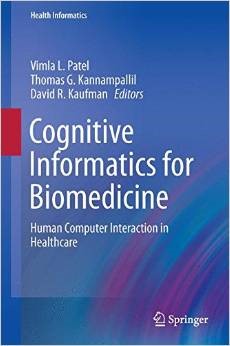Vimla L. Patel is the director of The New York Academy of Medicine Center for Cognitive Studies in Medicine and Public Health and lead editor of the new book, Cognitive Informatics for Biomedicine: Human Computer Interaction in Healthcare, along with Drs. Thomas G. Kannampallil and David R. Kaufman.
Health information technology (HIT) is at the center of modern health care and can facilitate health care reform. Billions have been invested in realizing the HIT promise—a safer, more effective and more efficient health care system. At its best, HIT can slash medication error rates, help us reduce disparities, possibly decrease hospitalization and mortality rates among the chronically ill, assist in clinical decision making, and cut hospital staffing needs. But we are still seeing significant resistance to HIT use.
While more than 80 percent of doctors report some effort to use Electronic Health Records (EHRs), 51 percent are only using basic functions, such as entering patient demographics. HIT-related frustration has even inspired a YouTube parody, EHR State of Mind (sung to the tune of Alicia Keye’s Empire State of Mind}, part of the #Letdoctorsbedoctors campaign. The chorus “EHRs!—crappy software some vendors made us.”
There’s a very clear message in the increasing popularity of #Letdoctorsbedoctors on social media—HIT is not working as well as it could for the people at the forefront of health care and its reform.
The Human Aspect of Design
The larger problem is that we are in a new era where technology has become part of everyday life, whether it’s a smartphone, banking system or a fitness device. New Apps are being developed almost daily, but many of the products are not error-proof or are not easily used for the intended purpose. People do not like to use them, even for important tasks such as monitoring their diabetes.
This is because technology is usually not designed with users in mind. Prior to editing our new book, Cognitive Informatics for Biomedicine: Human Computer Interaction in Healthcare (Springer), we spent several years investigating the nature of clinician/computer interaction in high-intensity environments, such as emergency rooms (ER) and intensive care units. My team’s primary focus was and is human cognition and its role in health behavior change.
We found that technology could sometimes overwhelm clinical teams. Occasionally exacerbating errors, causing mistakes in diagnosis or the dosing of medication. Yet, it also became clear that technology could play a major role in error mitigation, if human cognition and its interaction with socio-cultural environments were taken seriously in the context of computer design.
To learn more about how health care providers interacted with technology, we used sensors to track them in natural practice settings, observing unobtrusively how they operated during clinical workflow. We also observed the increasing number of ways technology changed doctor-patient interaction, as patients increasingly arrived at the ER clutching pieces of paper with questions generated by Google searches, as well as greater use of social media to share health information.
Training the Next Generation
To address this revolution in computer use, our book sets out to address key gaps in the theories, models and evaluation frameworks of human computer interaction (HCI) and human factors for research in biomedical informatics. It highlights the state of the art, drawing from current research in HCI. Second, it serves as a graduate-level textbook highlighting key topics in HCI relevant for biomedical informatics, computer science and social science students working in health care.
Through the book and my ongoing work with my colleagues at the Academy in our Center for Cognitive Studies in Medicine and Public Health, we intend to guide the next generation of designers in creating more effective, user-friendly and safe technology.
The objective is not just to #Letdoctorsbedoctors. It’s to ensure that we can accomplish all that is promised by health care reform—goals that will not be achieved unless EHRs and other HIT that is fundamental to improving the health care system work for every intended user.

View our COVID-19 Safety Protocols for attending NYAM public events.